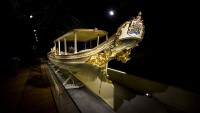 The 200-year-old Royal Barge of the Dutch monarchy is back on display at the National Maritime Museum (Het Scheepvaartmuseum) in Amsterdam after a meticulous restoration. On Monday, October 5th, the barge began its journey from a warehouse in Hoogwoud to Amsterdam. It was transported over water and land in stages over the course of two days. It arrived at its new home, a custom-built glass-walled boathouse on a jetty next to the museum’s landing, on Wednesday. A week later, the new Royal Barge was shown off to a crowd of 300 invited guests and as of October 15th, it is once again on public display.
The 200-year-old Royal Barge of the Dutch monarchy is back on display at the National Maritime Museum (Het Scheepvaartmuseum) in Amsterdam after a meticulous restoration. On Monday, October 5th, the barge began its journey from a warehouse in Hoogwoud to Amsterdam. It was transported over water and land in stages over the course of two days. It arrived at its new home, a custom-built glass-walled boathouse on a jetty next to the museum’s landing, on Wednesday. A week later, the new Royal Barge was shown off to a crowd of 300 invited guests and as of October 15th, it is once again on public display.
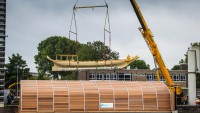 Known as the “golden carriage of the water” because of its dramatic gilded Neptune group figurehead and numerous other gilded ornaments, the Royal Barge has been out of public view since July of 2008. The museum had begun a comprehensive renovation program in 2007 requiring its entire collection to be moved temporarily. The barge was the last piece of the collection to leave the museum, and they had to cut in a hole in the wall to get it out of the building. When the museum reopened in 2011, there was no adequate space to display the barge, so it was kept in storage.
Known as the “golden carriage of the water” because of its dramatic gilded Neptune group figurehead and numerous other gilded ornaments, the Royal Barge has been out of public view since July of 2008. The museum had begun a comprehensive renovation program in 2007 requiring its entire collection to be moved temporarily. The barge was the last piece of the collection to leave the museum, and they had to cut in a hole in the wall to get it out of the building. When the museum reopened in 2011, there was no adequate space to display the barge, so it was kept in storage.
 Designed by 21-year-old architect Cornelis Jan Glavimans, the Royal Barge was built between 1816 and 1818 by order of King William I. William had declared himself King of the Netherlands, the first to hold that title, on March 16th, 1815, so his kingship was as new as kingdom when he commissioned the boat. There was a fashion among the European royal houses for luxurious rowing barges to be used on special state occasions. The brand new king of a brand new maritime kingdom was therefore keen to get an elaborately decorated rowing barge of his own, especially since barge travel was common in the Netherlands and wealthy families had their own barges just like they had their own horse-drawn carriages.
Designed by 21-year-old architect Cornelis Jan Glavimans, the Royal Barge was built between 1816 and 1818 by order of King William I. William had declared himself King of the Netherlands, the first to hold that title, on March 16th, 1815, so his kingship was as new as kingdom when he commissioned the boat. There was a fashion among the European royal houses for luxurious rowing barges to be used on special state occasions. The brand new king of a brand new maritime kingdom was therefore keen to get an elaborately decorated rowing barge of his own, especially since barge travel was common in the Netherlands and wealthy families had their own barges just like they had their own horse-drawn carriages.
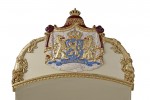 The barge is 17 meters (about 56 feet) long and seats 20 rowers. From the bow to the stern, it is embellished with gilded wood carvings. The main feature is the Neptune figurehead. The god of the sea sits on his shell carriage drawn by three seahorses (the mythological kind that are horses up top and fishes from the waist down, not the real animal). He holds his trident in one hand and the reigns in the other. The sides of the barge are decorated with floral elements including acanthus vines and orange branches (William was a scion of the House of Orange) and lions in a sphinx-like pose. On the stern of the barge is the royal coat of arms.
The barge is 17 meters (about 56 feet) long and seats 20 rowers. From the bow to the stern, it is embellished with gilded wood carvings. The main feature is the Neptune figurehead. The god of the sea sits on his shell carriage drawn by three seahorses (the mythological kind that are horses up top and fishes from the waist down, not the real animal). He holds his trident in one hand and the reigns in the other. The sides of the barge are decorated with floral elements including acanthus vines and orange branches (William was a scion of the House of Orange) and lions in a sphinx-like pose. On the stern of the barge is the royal coat of arms.
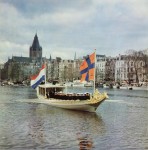 Once King William I had his golden carriage of the water, he never used it. For 23 years the Royal Barge twiddled its gilded thumbs until it finally had its maiden voyage carrying the new monarch William II at his inauguration on March 30th, 1841. In the next 150 years, the barge was used less than 30 times. It carried the monarchs for naval reviews, jubilees, special celebrations and foreign heads of state during official visits. The last time it saw service transporting royalty over the waters was on April 29th, 1962, during the celebration of the silver wedding anniversary of Queen Juliana and Prince Bernhard.
Once King William I had his golden carriage of the water, he never used it. For 23 years the Royal Barge twiddled its gilded thumbs until it finally had its maiden voyage carrying the new monarch William II at his inauguration on March 30th, 1841. In the next 150 years, the barge was used less than 30 times. It carried the monarchs for naval reviews, jubilees, special celebrations and foreign heads of state during official visits. The last time it saw service transporting royalty over the waters was on April 29th, 1962, during the celebration of the silver wedding anniversary of Queen Juliana and Prince Bernhard.
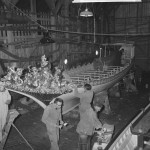 While it has spent the decades since its retirement on dry land and has been on permanent loan to the National Maritime Museum since 1983, the barge is still crown property and would be bound to come out of retirement if the monarch called it to duty. There was talk of the barge being deployed for the inauguration of King Willem-Alexander on April 30th, 2013, but the authorities were concerned about its seaworthiness so the idea was scrapped.
While it has spent the decades since its retirement on dry land and has been on permanent loan to the National Maritime Museum since 1983, the barge is still crown property and would be bound to come out of retirement if the monarch called it to duty. There was talk of the barge being deployed for the inauguration of King Willem-Alexander on April 30th, 2013, but the authorities were concerned about its seaworthiness so the idea was scrapped.
 Thanks to a one million euro donation from the BankGiro Lottery and the Cultuur Lottery, the National Maritime Museum was able to do a complete restoration of the barge not just to make it look shiny and new, but to ensure it is seaworthy and usable for future royal events. The cabin was removed and the hull stripped of paint. The oak keel and ribs were in surprisingly good condition underneath the yellowed and cracked paint. Nail holes were filled and the whole surface of the hull was sanded, primed, painted and varnished.
Thanks to a one million euro donation from the BankGiro Lottery and the Cultuur Lottery, the National Maritime Museum was able to do a complete restoration of the barge not just to make it look shiny and new, but to ensure it is seaworthy and usable for future royal events. The cabin was removed and the hull stripped of paint. The oak keel and ribs were in surprisingly good condition underneath the yellowed and cracked paint. Nail holes were filled and the whole surface of the hull was sanded, primed, painted and varnished.
 The gilded statues and ornaments were a little trickier. First the statues were X-rayed to identify structural issues. They found that the figures are made of many smaller pieces put together with screws and forged nails. The constant cycle of moisture and drying over the past two centuries caused large cracks in the wood that in the past were filled with hard compounds that in the long term
The gilded statues and ornaments were a little trickier. First the statues were X-rayed to identify structural issues. They found that the figures are made of many smaller pieces put together with screws and forged nails. The constant cycle of moisture and drying over the past two centuries caused large cracks in the wood that in the past were filled with hard compounds that in the long term  only exacerbated the instability. Restorers had to dismantle all of the wood parts, remove hundreds of hard fillings and then reassemble them all using synthetic resins. Then they had to reapply the gold leaf to areas where it had worn off. Restorers used 1,150 three-inch square leaves of gold leaf to restore the barge’s shine. The regilding was done at the museum so visitors could observe the work in progress.
only exacerbated the instability. Restorers had to dismantle all of the wood parts, remove hundreds of hard fillings and then reassemble them all using synthetic resins. Then they had to reapply the gold leaf to areas where it had worn off. Restorers used 1,150 three-inch square leaves of gold leaf to restore the barge’s shine. The regilding was done at the museum so visitors could observe the work in progress.
Here’s a brief video from AzkoNobel, a company that specializes in painting yachts which provided expertise on applying protective paint coatings to the barge. There are some neat views of the barge during the restoration process.
[youtube=https://youtu.be/C7o1IzsKNLQ&w=430]